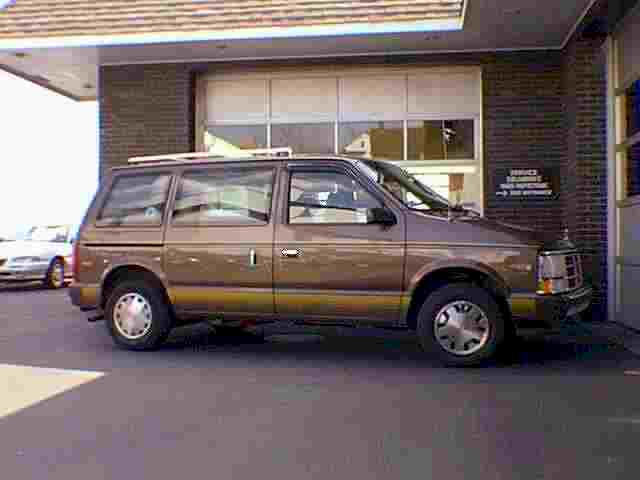
View of the Dodge Caravan.
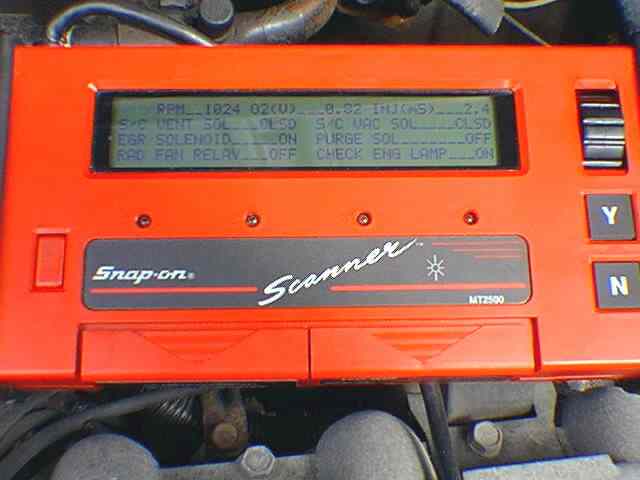
Ahhhh the rest of the story. Here we find the Scan Tool displaying
"Check Engine Lamp On".
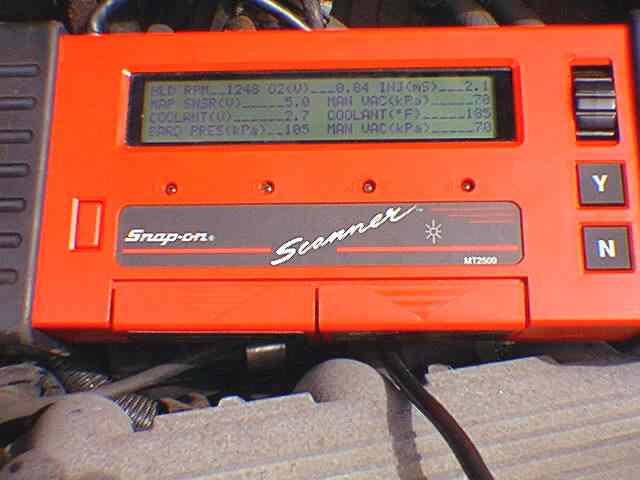
Notice that MAP voltage is 5V and MAP KPA is 70. This is where the
SBEC noticed MAP voltage was too high at start up. The 70 KPA is a default
value set by the SBEC.
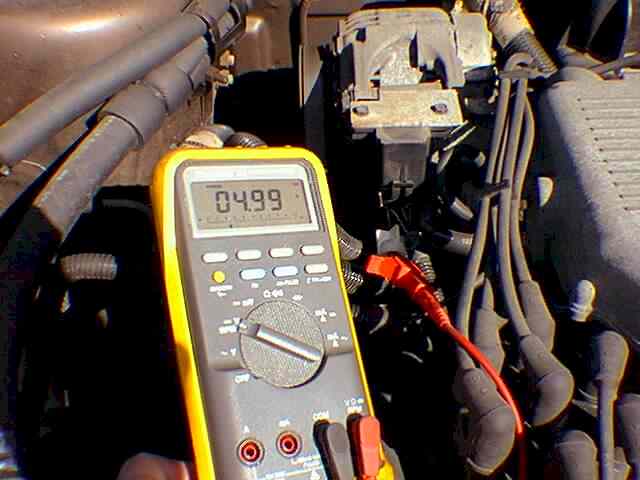
Here we see the Fluke 88 showing 4.99 Volts at the MAP sensors 5Volt
reference wire (VT/WT). This verified good reference voltage.
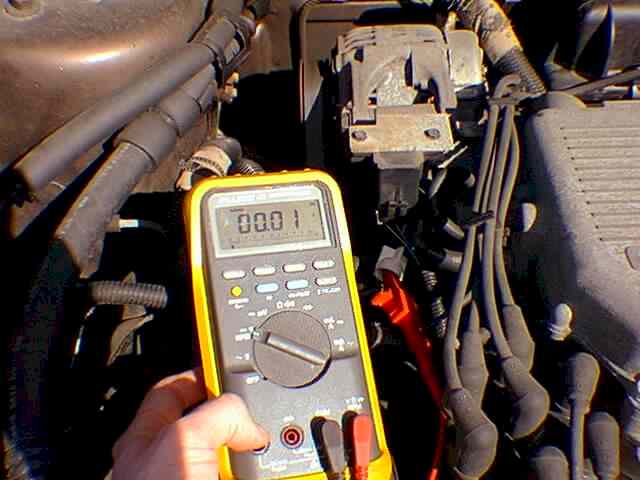
The MAP sensors ground wire, (BK/LB), looks good at 0.01 Volts, verifying
an acceptable ground.
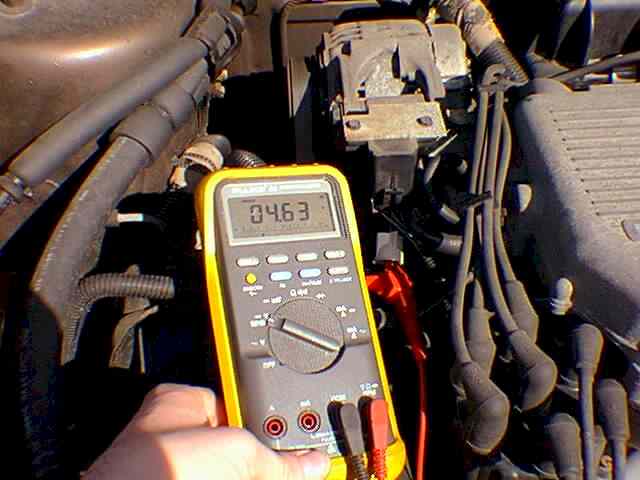
Hmmm trouble ahead...Notice the 4.63 Volts while connected to the
MAP sensors signal output wire (DG/RD). This is what is causing our fault
code.
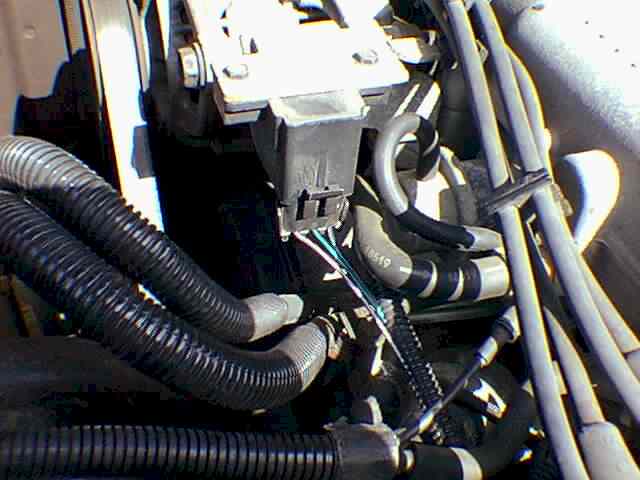
Here is the location of the MAP sensor, pretty easy to get to on this model.
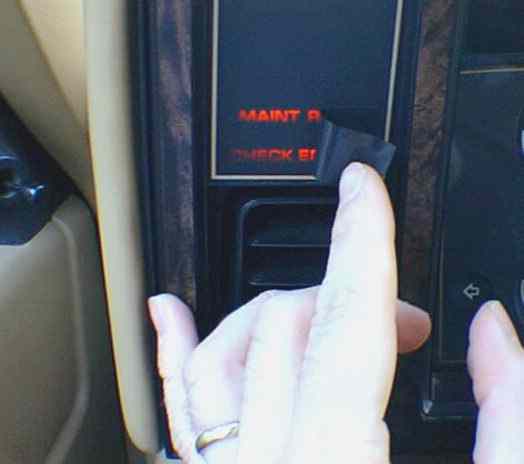
Here is where we found someone's idea of a band-aid for warning lamps.
Not exactly the correct way to repair a fault code. Both the check engine
lamp and the maintenance reminder lamp were on.
|
VEHICLE: 1990 Dodge Caravan
POWER TRAIN: 3.0L V6, 3-spd. A/T
MILEAGE: 90,383
SYMPTOM: Poor performance, holds back while driving, idles poorly.
With each broken down car, there is a broken down customer.
On this particular day, one of our regular customers was bringing in a new
client, and her vehicle for us to diagnose. This new customer felt that,
not only had her van let her down, but her mechanic as well. She was a little
upset because just recently the vehicle was looked at, and tuned-up by her
mechanic, yet it ran no better than before. She was quick to point out how
much she had already spent on the vehicle, but our regular customer had assured
her we could get to the bottom of things.
This vehicle is common enough, and the diagnostic capabilities
good enough that it should seem familiar to everyone. The Single Board Engine
Controller, (SEBC), controls fuel system delivery, ignition timing, idle speed,
emission control devices as well as charging system and air conditioning operation.
Most important to us is the SBEC's diagnostic capabilities. It can store
the usual trouble codes of sensor and circuit faults, indicate how many ignition
cycles have lapsed since a trouble code set, and is open to bidirectional
communication with a scan tool. This bidirectional communication allows
two different test groups to be controlled by the technician.
First the actuator test mode, (ATM), allows the technician
to control the circuits that are operated by the SEBC, running the ignition
coil, fuel injectors, automatic idle speed, (AIS), motor, alternator field
circuit and various relays and solenoids. This can simplify component diagnosis
because the circuit in question can be operated and then monitored. The
second part of this bidirectional communication is the memory resets that
allow specific pieces of the computers memory be reset to a preprogrammed
base level. Codes can be cleared, adaptive fuel strategy, minimum throttle
position and idle air control values can be reset. This can help verify proper
operation after a repair is made. For example if throttle bore deposits were
removed, the idle speed values can be reset to quicken proper idle speed control.
Diagnosis.
We started with a quick road test. As soon as the vehicle was started,
we noticed it ran rough for the first few seconds, then cleared up. The overall
performance while driving was good, no skipping, maybe a slight hesitation,
and the idle speed was not steady. We also did not observe any warning lights
on.
Diagnostic tip.
Common on late model Chrysler vehicles, if there is a system fault
the computer can see, the computer will wait a few seconds and then correct
the fault, substituting were it can, a good sensor value for a flawed value.
This is often obvious enough for the technician to notice, and the two or
three seconds it takes to substitute a good value almost seems to be planned
to catch your attention. The computer turns on the check engine lamp and goes
into what is called the limp home mode.
Surprises
We connected our scan tool and the surprises began. First we found
trouble codes present for the manifold absolute pressure (MAP) sensor circuit.
Code 14, indicating the MAP sensor signal voltage was too high, and code 13,
indicating there was no variation detected in the MAP sensor readings.
A browse through the different data stream parameters showed everything
appeared normal, everything but the MAP sensor readings. However, at the
end of the data stream there was an indicator reporting: "check engine lamp
on". This all makes perfect sense, bad sensor readings with associated trouble
codes, but were was the check engine lamp?
Wait a minute, all of a sudden we realize where the check engine
lamp is located, and at the same time find why we never saw it. Someone found
another use for electrical tape, to hide those nasty warning lamps. Would
hiding one be enough? No, the emission maintenance reminder (EMR) lamp was
covered too, and of course that was on as well. Sometimes when a repair takes
the typical "deeper you go, more you know" turn, you have to stop and think
about how all this is going to be explained to the customer. Your ability
to communicate the information you found, and the results of your tests, can
sometimes be more important to the customer than the repair itself.
Simple confusion
MAP sensor readings can be a little confusing, and Chryslers ability
to display substitute sensor values only adds to the confusion. Thinking back
to a time before computers, mechanics were taught the importance of understanding
manifold vacuum readings, and these readings were always measured in
"Hg or kPa. With computer controls, much closer monitoring of manifold vacuum
was needed. As a result barometric pressure is now monitored. However, we
must refer to manifold vacuum as a negative pressure. Now it can be measured
in relation to barometric pressure, the atmospheric air pressure of a given
altitude and temperature. The difference between the two is manifold absolute
pressure. MAP is barometric pressure minus manifold pressure (vacuum). Some
datastreams display manifold vacuum readings because they know it is easier
to relate to. Barometric pressure is measured by the MAP sensor at KOEO and
wide open throttle.
Our Chryslers SBEC also displays MAP sensor voltage. When sensor
voltage is low, around 1 volt, MAP is relatively low. When voltage is high,
near 5 volts, MAP is high. Or, to look at the values another way, it could
be stated that when MAP is high vacuum is low and that when MAP is low vacuum
is high. Our scan tool shows manifold vacuum is high, around 70kPa, but our
MAP sensor voltage is high, which indicates no manifold vacuum. The reason
they disagree is because the computer, after realizing the sensor reading
was incorrect, substituted a good vacuum reading, but left the bad sensor
voltage reading, so we could see what was at fault. Remember when the check
engine lamp is on, some of the data stream parameters displayed can be the
computers calculations and not actual sensor readings. Chrysler recommends
testing the MAP sensor by applying varied amounts of vacuum to the sensor
and verifying a minimum amount of voltage change. We checked the sensors 5V
supply wire, (VT/WT), and it was fine. We also checked the sensors ground
wire, (BK/LB), and that was fine too.
With the van idling we verified 19" of vacuum at the MAP sensor hose.
With a sensor completely failed as this one it was not necessary to perform
Chryslers varied vacuum test, but sometimes MAP sensor readings can be off
just enough to effect performance but still appear to be reading correctly.
We checked our Alldata for factory service bulletins but found
none related to our symptoms. Often, other Chrysler models have TSB's referring
to new hoses and/or locations for the MAP sensors because moisture from the
intake manifold could accumulate in the sensor and cause it to fail.
Dear customer
Now we had one more thing to explain to our new customer than a failed
MAP sensor, we had also uncovered the EMR lamp. On Chrysler vehicles, the
SBEC turns on this lamp at different mileage intervals to indicate an emission
service is due. On this vehicle we assume the lamp is on for the 82,500 mile
service, when the oxygen sensor is scheduled to be replaced.
Of course for all we know the lamp may have been covered since the
60,000 mile indication which was for a different service. The customer reported
they had already replaced the oxygen sensor in the past, but also reported
her mechanic had covered up those lamps and told her she did not have to
bother with any of that. Unfortunately some technicians still get so concerned
about saving their customer money, that they fail to realize their job is
only to offer the best service for their customers vehicle, based on their
knowledge and the manufacturers recommendations. A new EGR valve would seem
much to expensive until the price of burnt pistons is considered.
We replaced the failed MAP sensor, verified the sensors operation
on the scan tool, and then reset the EMR lamp and cleared the trouble codes.
A last road test showed a change from fair performance to great performance.
A little tape over the odometer reading and you would think the truck was
new.
After Thoughts
As we were correlating information for this article we did find a technical
service bulletin for the MAP sensor. When the car was in the shop, we looked
up TSB's under the MAP sensor section of our Alldata system and some were
listed but none for our symptom. Later, during the article's research, we
did find TSB# 18-03-90 stating to replace the MAP sensor and its vacuum hose
for codes 13 or 14. This TSB was not listed with the other bulletins in the
MAP sensor area, but was in the "Powertrain Management" section. We called
Alldata and asked them to also place the TSB under the MAP sensor area. This
extra information just shows you how the automotive industry is far from being
perfect. This MAP sensor TSB should be in the MAP sensor area. Yet one could
argue that we could have looked under powertrain management. Blame could
be placed on either party. Everyone makes mistakes. Hopefully the same mistakes
are never repeated.
Mark Giammalvo MAT, SAE, L1
Glenn Giammalvo MAT, L1
 Glenn & Mark
Glenn & Mark

|

